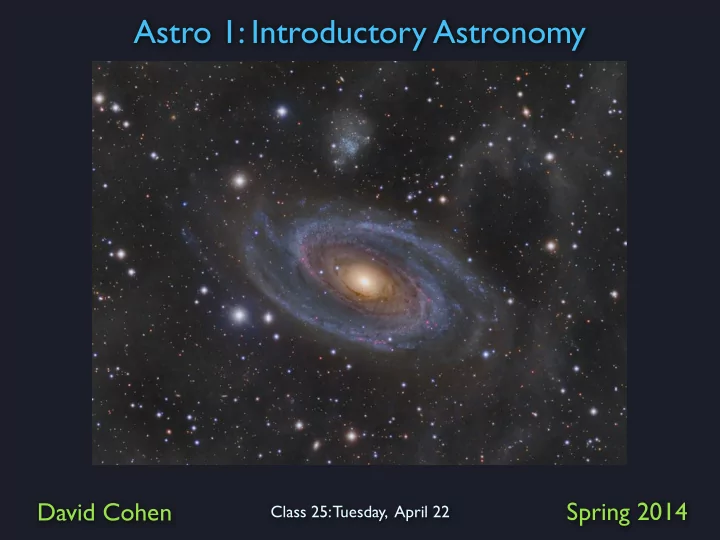

Astro 1: Introductory Astronomy David Cohen Spring 2014 Class 25: Tuesday, April 22
http://apod.nasa.gov/apod/ap130429.html
1757 based on star counts in different directions William and Caroline Herschel They didn’t recognize that dust was absorbing the light from more distant stars, so their estimate of the Galaxy’s size was too small, and they also therefore incorrectly thought that we were close to the center.
http://apod.nasa.gov/apod/ap110520.html Galactic center
Globular clusters are distributed symmetrically around the center of the Milky Way...and the Solar System is clearly off to one side of the distribution http://apod.nasa.gov/apod/ap130501.html
A coherent picture of the Milky Way emerged by the mid-20th Century
Disk and Halo stars have different sorts of orbits
http://apod.nasa.gov/apod/ap130416.html
http://apod.nasa.gov/apod/ap110520.html
stellar wind bubble - returning gas to the interstellar medium (ISM) http://apod.nasa.gov/apod/ap080813.html
http://apod.nasa.gov/apod/ap061018.html
A “planetary nebula” - death of a low-mass star http://apod.nasa.gov/apod/ap140110.html
Supernova also return metal-rich gas to the ISM - it starts out hot, here in X-rays http://apod.nasa.gov/apod/ap020824.html
Supernova also return metal-rich gas to the ISM - it starts out hot, here in X-rays http://apod.nasa.gov/apod/ap020824.html
Supernova remnants age...and fade into the interstellar medium, eventually cooling and becoming regular interstellar clouds...but enriched in heavy elements http://apod.nasa.gov/apod/ap060519.html
Infrared Milky Way http://apod.nasa.gov/apod/ap080605.html Green-coded wavelengths are from PAHs (polycyclic aromatic hydrocarbons) Red-coded wavelengths are from dust warmed by starlight
How do we know globular clusters are old? http://apod.nasa.gov/apod/ap130501.html
HR diagram shows the lower part of the main sequence, but no upper part http://en.wikipedia.org/wiki/Globular_cluster
HR diagram shows the lower part of the main sequence, but no upper part main sequence “turn off” http://en.wikipedia.org/wiki/Globular_cluster
Spiral structure: very luminous stars and gas clouds tend to occur in spiral arms
H II regions (H “two” indicating ionized hydrogen)
The Orion Nebula is an H II region http://apod.nasa.gov/apod/ap120715.html
Spiral arms are where most of the gas, dust, and young massive stars are
Recommend
More recommend